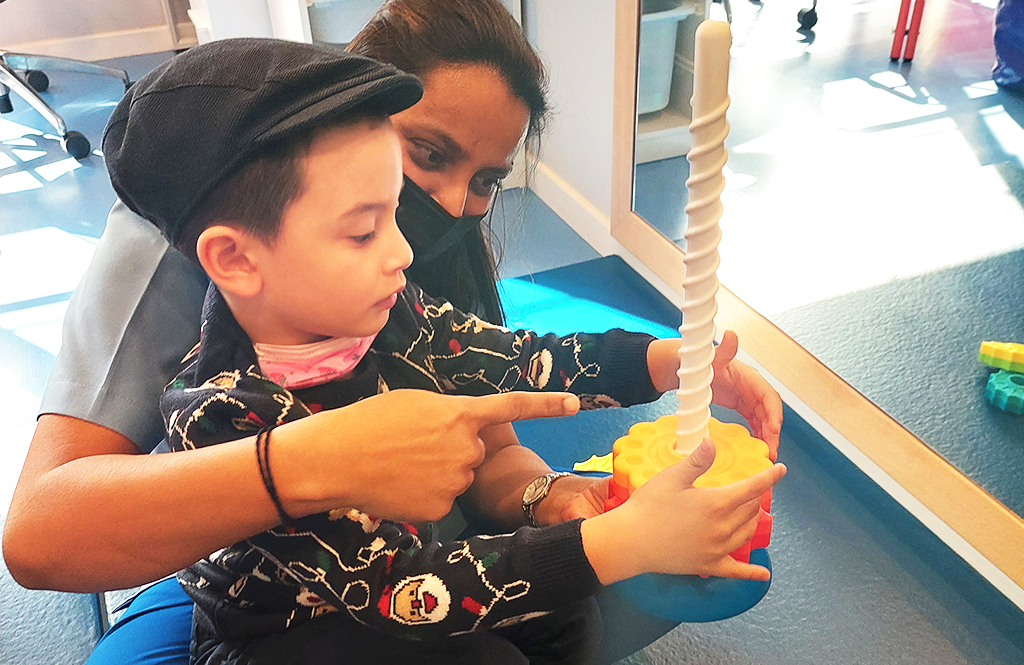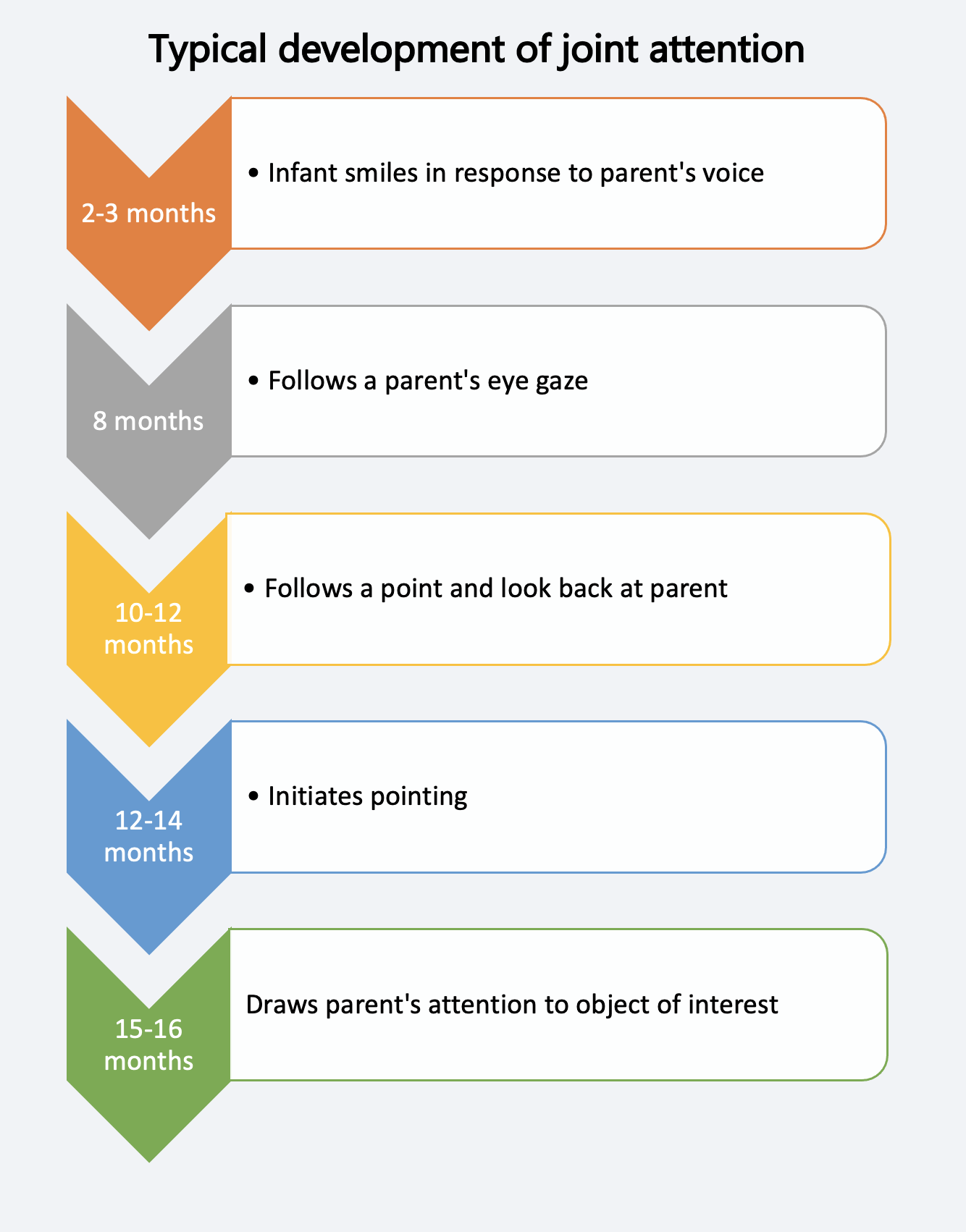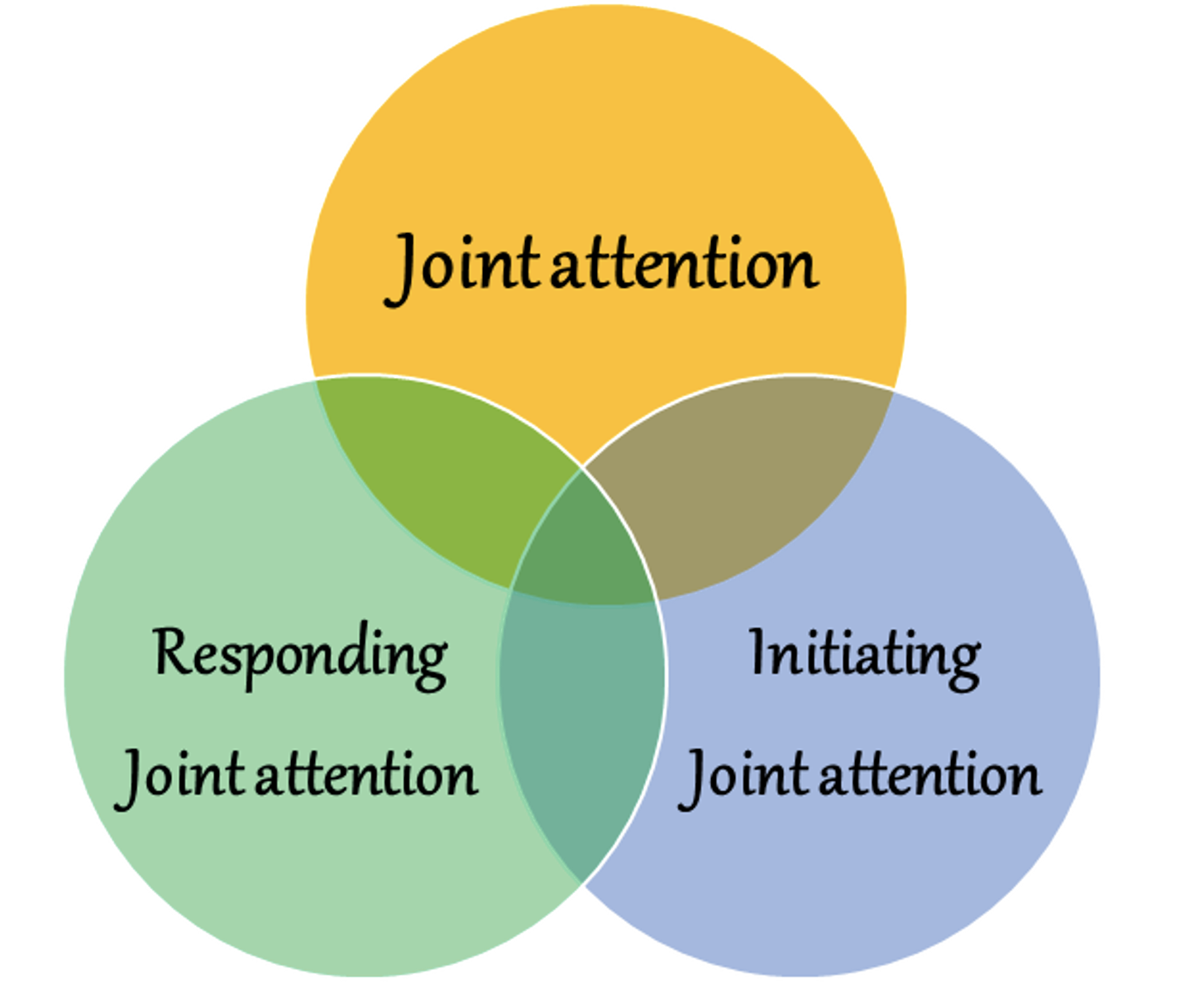

The importance of joint attention skills

Zakiya Gupta
DHA License Number: 00218087-003
Senior Occupational Therapist

What is joint attention?
You are at the park with your toddler when an airplane flies overhead. He/she runs to you, tugs your sleeve, points up, and says, “Pane!” He/she looks at you as you follow his/her finger. You look back at him/her with wide eyes and say, “I see it too! It’s an airplane! It’s flying in the sky.”
You are also playing blowing bubbles with your child, and both of you continuously go back and forth between focusing on blowing and popping the bubbles and engaging with each other.
These are two examples of joint attention.
Joint attention is the ability to share a common focus on something (people, objects, a concept, an event, etc.) with someone else. It involves the ability to gain, maintain, and shift attention.
(Daymut 2009)
How does joint attention develop in children?
Children at the age of one rely on the hand movements of their parents or caregiver to coordinate visual attention instead of gaze following. Touch also plays a significant role in promoting joint attention as it can be used to attract an infant’s attention, and it can also help them understand the difference between themselves and others in the earliest social interactions.
Between the age of 1.1 and 2.0 years, children learn to follow and direct others’ attention by using language. Towards the end of their second year, they use common verbal symbols that enable more complex talks, such as “Mama, look.”
As joint attention skills become more sophisticated, the scope of the ability expands through the first three years of life. Children understand that others’ attentional focus can be modified by language or gestures, which indicates that they have reached a more sophisticated level of social cognition.

What are the types of joint attention?
There are two main types of joint attention:
- The child responding to parents/caregivers’ bid for joint attention. For example, a parent and child are playing together. The parent looks at and points to a toy car and says, “Look at that car!” The child responds by following the parent’s gaze and point, and so looks at the car. At about 12 to 14 months of age, the child will start to check back with the parent, alternating his/her gaze between the car and the parent, confirming that they are both still attending to the car. Responding is easier than initiating.
- The child initiating joint attention. For example, a child is holding a toy. He/she uses gestures, such as pointing to or holding up the toy, and gazes, including looking at the parent and then back at the toy to ask the parent to look at the toy. As the child gets older, he/she may use vocalization as an additional means to directing the parent’s attention.
Initiation of joint attention by the child is the most important type of joint attention as it demonstrates that the child is socially motivated.

Why is joint attention important?
Infants’ ability to engage in joint attention is an important developmental milestone.
Joint attention supports development in several ways, including by promoting the following skills:
- Social skills: Joint attention serves as a foundation for the development of early social and cognitive skills. The social skills involved in joint attention—initiation, responding to others’ initiation, sustaining back-and-forth interactions, etc.) are integral to communication, relationships, learning, and collaborating.
- Language skills: Joint attention interactions are crucial for language development. Specifically, the language children hear and see during joint attention interaction with their caregivers is strongly linked to early vocabulary development. When caregivers share attention with their infants, and comment on the object or event on which they are focusing, infants acquire new words more easily and efficiently.
- Attention skills: Joint attention helps little ones learn to sustain focus, as well as shift focus back and forth between two things.
- General learning: Joint attention is also associated with the depth of information processing in infants, as well as with individual differences in childhood measures of IQ, self-regulation, and social competence.
Does my child have difficulties with joint attention?
It can be hard to determine whether your child is finding it difficult to share joint attention activities with you.
Some signs of joint attention difficulties are:
- The child is avoiding eye contact.
- It is difficult for him/her to follow your eye gaze to look at the same thing.
- He/she is unable to sustain joint attention during social play.
- He/she has difficulty sharing emotional states with another person.
- He/she finds it difficult to use direction of gaze or pointing to direct the attention of others to something within their world.
What can you do to promote joint attention?
As a parent or caregivers, you can stimulate your child’s joint attention skills through the following ways:
Respond in meaningful ways to your little one’s cues to interact. When your child shows you a toy, make sure you stop what you are doing and acknowledge his/her attempt to interact.
Set aside distraction-free time for engaging in free play with your child. Some ideas of free play activities are:
- Pretend play, dressing up, playing with action figures: Engage your child in looking at you and to pretend play toys, back and forth.
- Gain your child’s attention by engaging in activities like playing peekaboo and blowing bubbles.
- Play games that involve taking turns, such as rolling a ball between each other.
- Develop imitation skills during play in both fine and gross motor games, such as Simon Says.
- Follow your child’s lead and play with their preferred toy or activity.
- Use cause and effect play: Engage your child in play such as filling and dumping or pushing/pulling toys, then pause the activity and wait for him or her to look at you before continuing.
- Create situations for your child to initiate a request for you to look at something that interests him/her. For example, try rearranging the environment, bringing in something new to encourage your child to seek your attention to show you what has changed.

Connect by getting down on your child’s level and using eye contact, words, and nonverbal language, including gestures like pointing. Encourage your child to look at you to develop joint attention. As much as possible, be at or below the child’s eye level as it is hard for kids to look up continually at adults, looking straight ahead or below is much easier. You can stand in your child’s line of sight and hold objects up to your eyes when you give them to your child—two inches from your face, right in front of the bridge of your nose. To better capture your child’s attention, use exciting toys that perhaps spin or light up or use an animated voice and exaggerated expressions.
Have fun!A little enthusiasm can go a long way in encouraging and sustaining joint attention.
Sources:
- Baby sparks. (2019). Joint Attention: Why Tuning in to Your Child is So Important.
- Amy M. Lieberman (2016). Eye gaze and Joint Attention. NSF Science of learning center on visual language and visual research brief no.5.
- Lindsay Birchfield, M.S. BCBA, LBA. Joint Attention: Fostering Social Communication Skills.
- Freya Eriksson (2019). Joint attention and language acquisition- A longitudinal study of joint attention in parent-child interaction.


